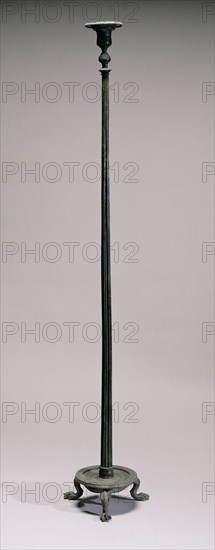
Sujet
Candelabrum, A.D. 1-79. Creator: Unknown.
Légende
Candelabrum, A.D. 1-79. Additional Info: One of a pair of identical bronze candelabra (lampstands) that once belonged to the household furnishings of a Roman villa. Architectural in inspiration, these candelabra take the form of a tall fluted column rising from a base with three lion’s paws. At the top, a vase-shaped element supports a circular disk designed to hold an oil lamp. The decoration around the disk includes intricate patterns of tongues and florals. Both candelabra are formed from several separately made and assembled components: the tripod base, a fluted shaft, the vase-shaped decorative element, and finally the circular plate on which the lamp sat. The individual parts of the stand are decorated with a variety of relief moldings and floral designs. The kidney-shaped pattern midway down the krater-shaped element of the candelabrum even has silver inlay.Designed to support an oil-burning lamp, many stands of this type have been discovered in houses at Pompeii, Herculaneum, and Boscoreale, which were destroyed by the eruption of Mount Vesuvius in A.D. 79. The height of this candelabrum indicates that it was meant to stand on the floor, but shorter, tabletop versions are also known.
Crédit
Photo12/Heritage Images/Heritage Art
Notre référence
HRM24A66_132
Model release
NA
Property release
NA
Licence
Droits gérés
Format disponible
27,6Mo (766,2Ko) / 16,5cm x 42,0cm / 1944 x 4960 (300dpi)